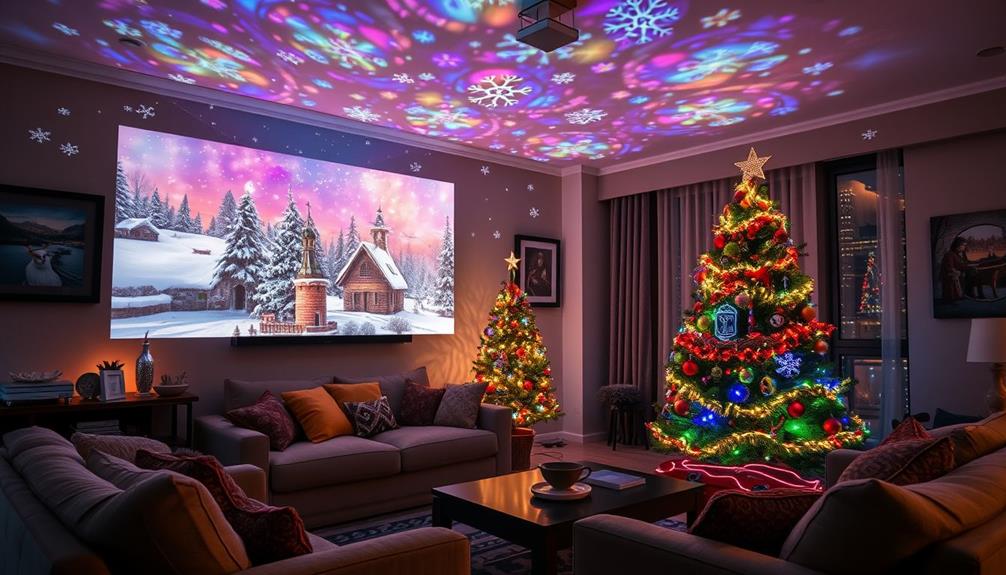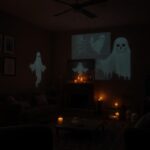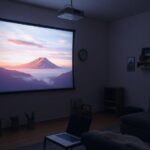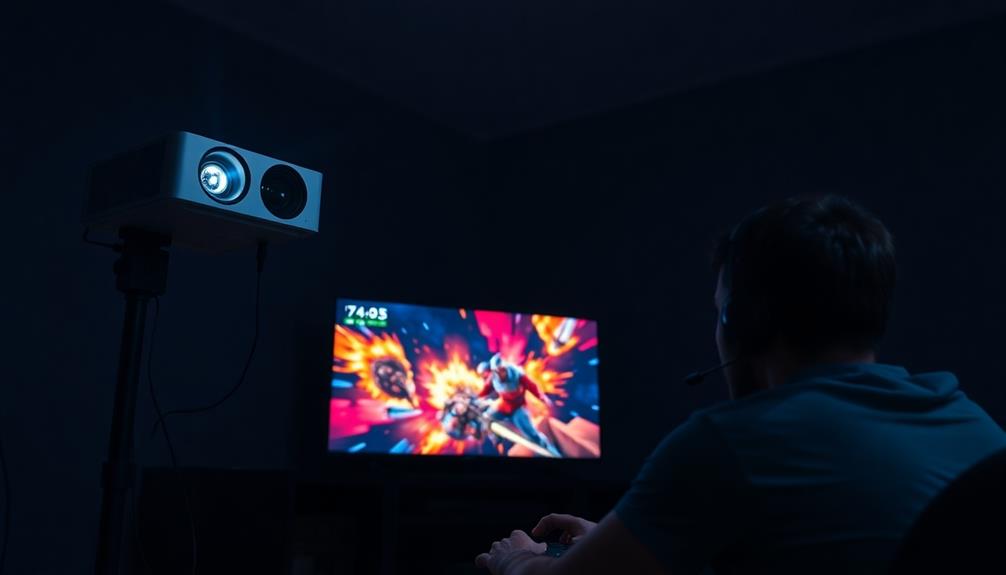You can turn your holiday celebrations into dazzling light shows by using your projector creatively. First, choose the right type of projector—laser or LED options work well. Select light-colored walls or semi-translucent surfaces for the best projection. Position your projector about 10-15 feet from the display area, adjusting its angle for maximum clarity. Use thematic images like snowflakes for Christmas or ghosts for Halloween to captivate your audience. To enhance your display, try layering different projections. By exploring these techniques, you can elevate your festive atmosphere—even more ideas await to help you shine this season!
Key Takeaways
- Select the right type of projector based on your needs, such as gobo for custom designs or laser for vibrant displays.
- Choose smooth, white, or light-colored surfaces for optimal brightness and clarity of projections.
- Position projectors 10-15 feet away from surfaces and adjust angles to avoid distortion and hot spotting.
- Layer different projectors and combine static and dynamic images for engaging and visually striking displays.
- Ensure projectors are weatherproof for outdoor use and secure them properly for stability and visibility.
Projector Setup for Holiday Displays
When setting up your projector for holiday displays, it's vital to choose one that's designed for outdoor use and has a lumen rating of over 1000. This guarantees your projected image remains vibrant and visible, even in ambient light conditions.
To create a truly enchanting atmosphere, consider incorporating elements from Island Getaways that evoke a sense of adventure and warmth. For your projector setup, position it about 10-15 feet from the display surface; this distance allows you to cover an area of up to 2,500 square feet effectively.
To enhance clarity and durability, consider using semi-translucent projection materials like AtmosFX Window Projection Material. This will make your displays pop, especially when showcasing festive scenes.
It's also important to secure your projector using stakes or mounts to prevent movement caused by wind; stability is key to maintaining a clear image.
Experimenting with different angles can help you avoid hot spotting and promote even light distribution. If you have multiple projectors, utilize them to create layered effects, adding depth to your holiday decorations.
With the right projector setup and careful positioning, your Christmas Light Projector can transform your home into a magical holiday wonderland.
Choosing the Right Projection Surface
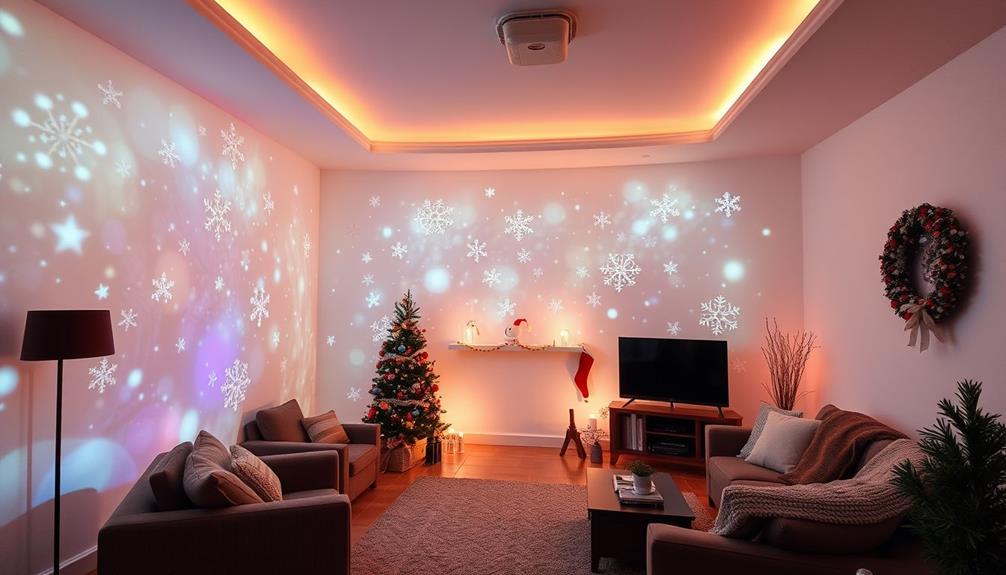
When choosing the right projection surface, think about visibility and the impact you want to create.
Consider using a high-quality surface that can enhance the clarity of your visuals, such as those found in essential components for home theaters.
Smaller, semi-translucent surfaces can enhance your projections while ensuring they're durable and effective.
Don't hesitate to experiment with unique shapes and unconventional surfaces to make your holiday display truly stand out.
Ideal Projection Surfaces
Selecting the right projection surface is essential for making your holiday decorations truly pop. When using a laser projector, you'll want to take into account several ideal projection surfaces to maximize the impact of your displays.
For instance, studies suggest that cats' emotional attachment can be enhanced by creating a warm and inviting atmosphere with your holiday lights.
Here are some options to think about:
- White or light-colored walls: These enhance brightness and color accuracy, making your images stand out effectively.
- Semi-translucent materials: Products like AtmosFX Window Projection Material capture light beautifully and can be easily cut to fit any window.
- Unusual-shaped windows: Bay windows, for example, create dynamic displays that draw attention from passersby.
- Unconventional surfaces: Don't shy away from projecting onto shower walls or glass doors; these can add unique and engaging elements to your decorations.
- Smooth surfaces: Make sure your chosen projection surface is free of obstructions for clarity and to avoid distortion.
Surface Preparation Tips
To guarantee your holiday projections shine brightly, preparing your surface is key. Start by choosing smooth, light-colored surfaces for the best projection quality. These surfaces reflect light effectively, enhancing the visibility of your images and animations. Walls, fences, and large screens work well, while rough or dark surfaces can distort your projected content.
Here's a quick reference table to help you choose the right surface:
| Surface Type | Recommended? |
|---|---|
| Smooth Walls | Yes |
| Textured Surfaces | No |
| Light-Colored Sheets | Yes |
For outdoor displays, consider using white or light-colored sheets. You can easily hang these to create a flat projection surface. Avoid surfaces with excessive texture or patterns, as they'll distort your images and reduce clarity.
Lastly, don't forget to test different surfaces and angles before your event. This allows you to find the spots that yield the clearest and most vibrant projections. By focusing on effective surface preparation, you'll guarantee your holiday decorations dazzle and delight all who see them!
Seasonal Decoration Ideas
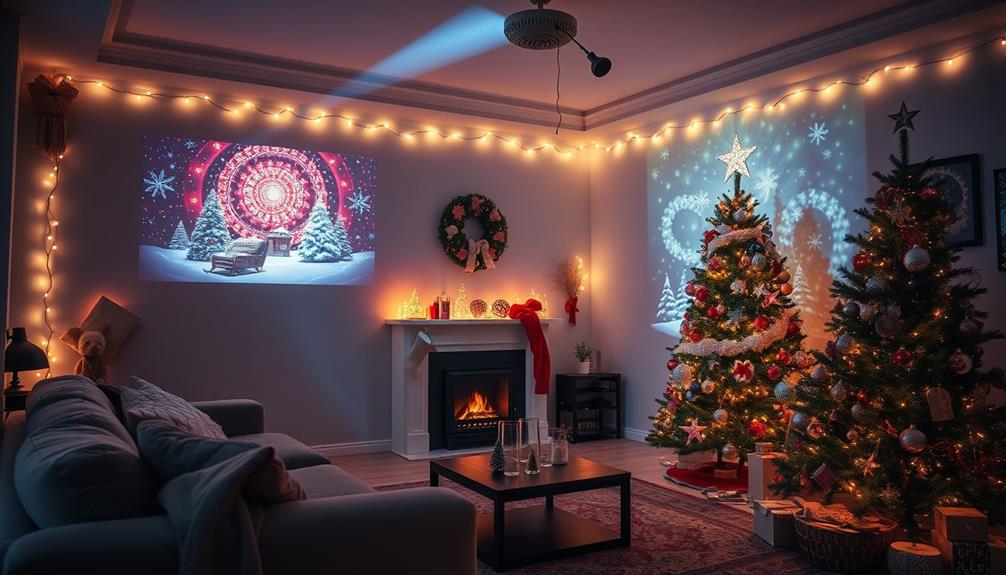
Transforming your home for the holidays can be as simple as using a projector to create stunning seasonal displays.
Projectors can project themed visuals like snowflakes, Santa, or even spooky Halloween scenes, turning ordinary spaces into festive environments. By utilizing semi-translucent projection materials, you can achieve life-size images and animations, perfect for enchanting guests and passersby.
Additionally, incorporating unique entertainment ideas that reflect your personality can elevate the festive atmosphere even further, such as showcasing local artists' holiday-themed works alternative entertainment in London.
Here are some seasonal decoration ideas to get you started:
- Halloween: Create eerie atmospheres with ghostly images or animated pumpkins.
- Thanksgiving: Project autumn leaves or harvest scenes to celebrate the season.
- Christmas: Use your projector to display twinkling snowflakes or Santa's sleigh.
- New Year's: Celebrate with fireworks or shimmering confetti effects.
- Valentine's Day: Set a romantic mood with hearts and love quotes.
Layering these projections with traditional decorations enhances the visual appeal, making your home truly magical.
For larger areas, consider using multiple projectors to guarantee thorough coverage of your decorations. With just a bit of creativity, you can transform your space into a festive wonderland that lights up the holiday season!
Tips for Effective Light Shows

To create stunning light shows, you need to choose the right projection surface, as this can make a big difference in clarity and impact.
Consider the ambient light in your space, since darker conditions will enhance the overall quality of your display. For instance, if you're planning an outdoor display, think about how water parks in Washington DC often utilize lighting to create an engaging atmosphere.
Optimal Projection Surface Selection
When choosing the best surface for your holiday light shows, remember that light-colored and smooth materials will greatly enhance projection brightness and clarity.
Utilizing the principles of minimalist living from the Tiny House Movement Overview, using fewer but more impactful decorations can create stunning visuals that captivate your audience.
Here are some ideal projection surface options to take into account:
- Windows: Smaller glass surfaces create life-size displays visible from a distance.
- Garage Doors: These larger surfaces allow for unique and expansive projections.
- Exterior Walls: They provide a blank canvas for creative designs and themes.
- Semi-Translucent Materials: Utilize products like AtmosFX Window Projection Material for improved image capture.
- Clear Areas: Verify the surface is free of obstacles and debris for uninterrupted projections.
Ambient Light Considerations
Ambient light plays a crucial role in the effectiveness of your holiday light shows, so it's important to create the right environment for your projections. To achieve the best results, aim for a darker setting, as this greatly enhances projection quality, resulting in sharper and more vibrant images.
If you have bright outdoor lights, consider replacing them with colored bulbs that align with your holiday theme—think red and green for Christmas! Effective keyword clustering and topic clustering can also guide you in creating themed displays that resonate with your audience.
Using blackout curtains or dark sheets can also help minimize unwanted light interference, providing a more efficient backdrop for your displays.
When it comes to projector placement, be mindful of avoiding hot spotting. Adjusting the angle and height of your projector can dramatically influence the visibility and impact of your decorations. Don't forget to utilize keystone correction features to fix any distortion that may arise from angled projections.
Experiment with different projector placements until you find the ideal setup. The right combination of reduced ambient light and thoughtful positioning will elevate your holiday light shows, ensuring they leave a lasting impression on your audience.
Happy projecting!
Creative Layering Techniques
Transform your holiday light displays by embracing creative layering techniques that can elevate your projections to a whole new level.
By combining various projectors and techniques, you can create a dynamic light show that captivates your guests and transforms your living room into a festive wonderland.
For instance, just as a self-cleaning mechanism enhances vacuum performance, layering your projectors can maintain visual effectiveness and intrigue.
Here are some tips for effective layering:
- Mix projectors: Combine laser projectors with LED models for depth and variety.
- Vary heights and angles: Position multiple projectors at different heights to enhance coverage and immersion.
- Dynamic and static projections: Use still images alongside moving animations, like snowflakes or Santa, to keep the display engaging.
- Incorporate color-changing projectors: Use models like the Spectrum RGB Moving Firefly Laser Light Projector for vibrant color combinations.
- Experiment with surfaces: Project onto walls, trees, or even the ground to create a unique environment.
Creative Projection Techniques

There are countless ways to elevate your holiday decorations using creative projection techniques. You can use your projector to transform unconventional surfaces, like shower walls or building sides, into stunning displays that surprise and delight viewers. By experimenting with different themes, you'll create a visually rich atmosphere that captures the spirit of the season.
To enhance your projections, consider using multiple projectors. This allows you to layer images and patterns, making your display more dynamic and engaging. Remember to think about your interior layout and window placements, ensuring that projections are visible from various angles and cover the right square feet of space.
Here's a simple table to inspire your creativity:
| Projection Surface | Theme | Interaction Level |
|---|---|---|
| Shower Wall | Winter Wonderland | High |
| Living Room Wall | Holiday Motifs | Medium |
| Outdoor Building Side | Seasonal Patterns | Low |
| Bedroom Window | Cozy Night Sky | High |
Encourage viewer interaction by choosing surfaces that invite close-up viewing, enhancing the overall festive experience for everyone.
Types of Holiday Projectors
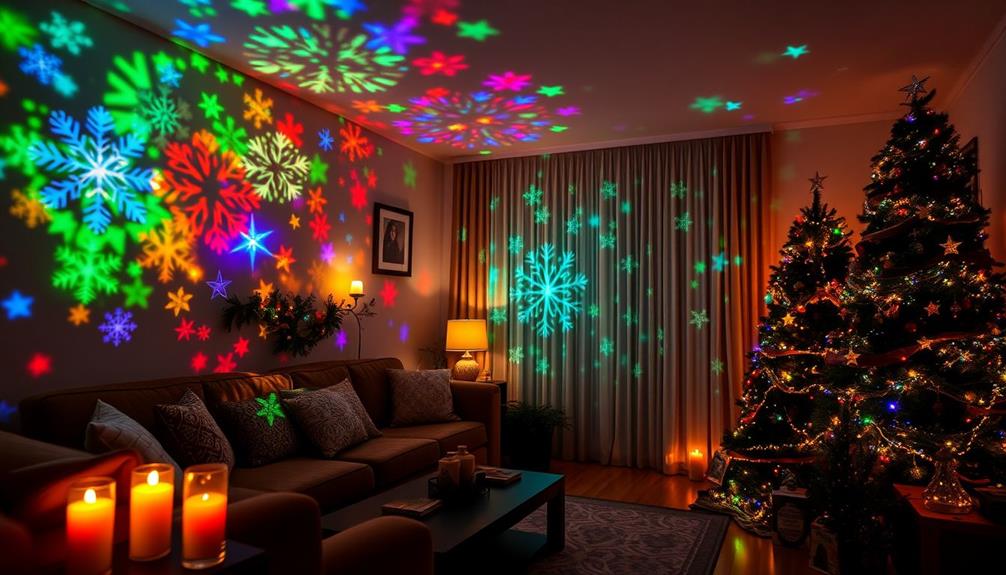
When choosing a projector for your holiday decorations, you'll find a variety of types that can enhance your seasonal themes and designs.
From the vibrant displays of laser projectors to the customizable options of gobo projectors, each one offers unique effects to elevate your festive atmosphere.
For large surfaces such as walls and ceilings, consider how airless paint sprayers can help create a uniform application of paint if you're decorating your space.
Whether you prefer static images or dynamic animations, there's a perfect projector to match your holiday vision.
Projection Types and Effects
As the holiday season approaches, choosing the right type of projector can elevate your decorations significantly.
With various options available, you can create a stunning visual experience that captures the festive spirit. For instance, just as coffee scrubs can improve circulation, the right projector can enhance the ambiance of your gatherings.
Here are some popular projection types and their effects to contemplate:
- Laser Projectors: These create vibrant pinpoints of color, filling your space with dynamic light patterns.
- LED Projectors: Known for their energy efficiency and long lifespan, they're perfect for those looking to save on energy costs while enjoying beautiful displays.
- Gobo Projectors: Ideal for customizable designs, you can project themed images like snowflakes or holiday greetings.
- Hologram Projectors: These display moving animations, such as Santa and his reindeer, adding a magical touch to your festivities.
- Static vs. Dynamic Projectors: Static projectors offer still images, while dynamic projectors provide moving animations, giving you options for various visual effects.
Seasonal Themes and Designs
Selecting the right projector isn't just about the technology; it's also about the seasonal themes and designs you want to create. You have a variety of options to enhance your holiday decor, each offering unique features.
Here's a quick overview of popular types of holiday projectors:
| Projector Type | Features | Best For |
|---|---|---|
| Laser Projector | Vibrant pinpoints and colors | Bright, eye-catching displays |
| LED Projector | Energy-efficient and long-lasting | Budget-friendly, outdoor use |
| Gobo Projector | Customizable designs and patterns | Personalized holiday themes |
| Hologram Projector | Moving animations like snowflakes | Dynamic, engaging displays |
| Static Projector | Still images and patterns | Classic holiday ambiance |
Each type has its strengths, so consider what atmosphere you want to create. If you're after a classic feel, static projectors can set the mood. For something more lively, hologram projectors can bring your decorations to life. No matter your choice, many projectors are waterproof, ensuring your displays withstand winter weather. Enjoy transforming your space this holiday season!
Cost Considerations for Projectors
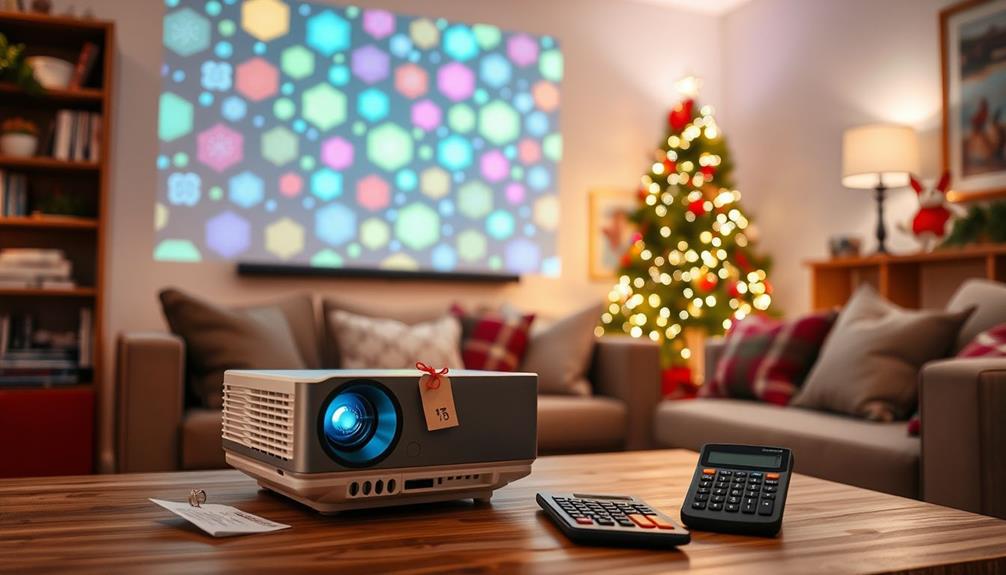
Considering cost is essential when choosing a projector for your holiday decorations. You want to find an option that fits your budget while still delivering the festive flair you desire.
Here's a quick breakdown of what you can expect to spend:
- Basic projection lights: These red and green options can be found for as low as $10 to $50, making them a budget-friendly choice.
- Customizable image projectors: If you're after more personalized displays, these typically range from $100 to $300.
- DIY projector options: Get creative and save money by making your own projector for basic holiday displays.
- Feature variations: The price can vary considerably based on features like sound, animation, and image variety, so consider what's essential for your needs.
- International pricing: Even if you're overseas, similar low-cost projectors can be found around AU$50, ensuring everyone can join in on the holiday spirit.
Features to Look For
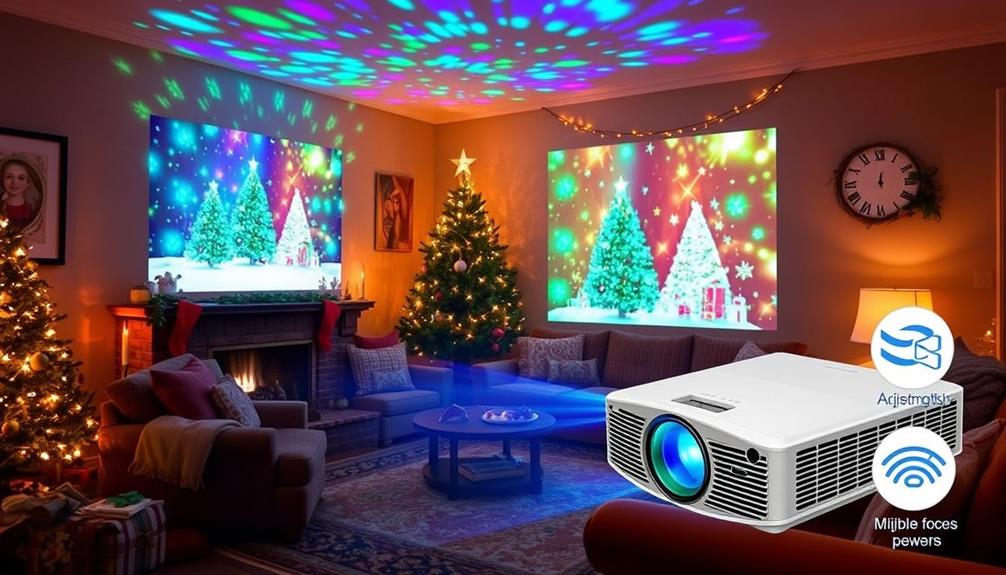
When choosing a projector for your holiday decorations, it's important to focus on key features that enhance your display.
Start by looking for projectors with high brightness levels, measured in lumens. This guarantees your projections are vibrant and clear, especially in outdoor settings or during dusk.
Next, consider models with adjustable focus and keystone correction features. These will help you easily align and optimize image quality on various surfaces, making your decorations look their best.
If you plan to use the projector outdoors, verify it's weatherproof. This feature will protect it from rain, snow, and other environmental factors.
Also, check for multiple light options. Laser lights typically provide clearer and more vibrant projections than LED lights, making them a great choice for holiday displays.
Enhancing Outdoor Displays
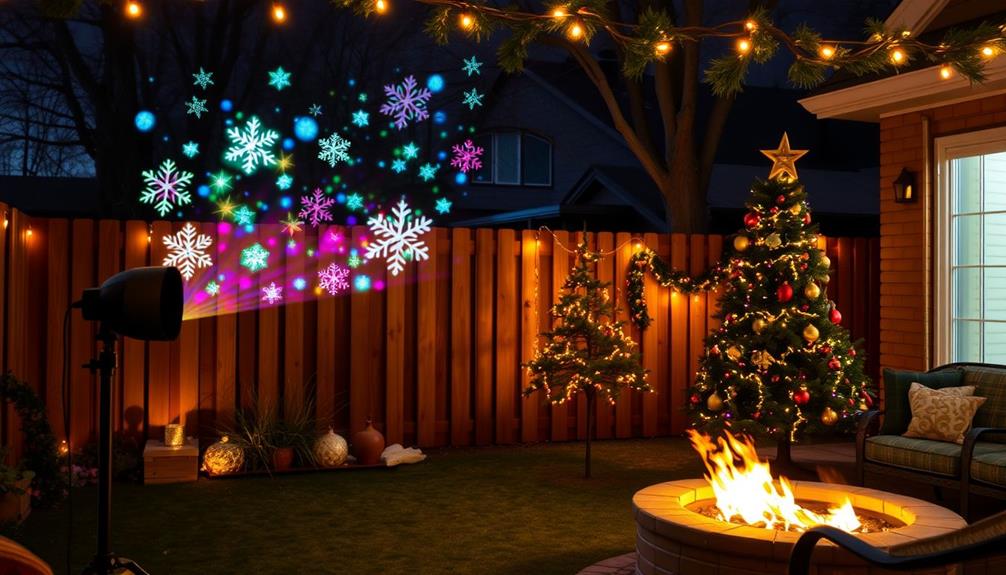
Enhancing your outdoor displays takes your holiday decorations to a whole new level.
With the right setup, you can transform your yard into a dazzling spectacle that captures everyone's attention. Here are some tips to elevate your outdoor display:
- Position your projector at least 10 feet away from the display surface for maximum coverage – some models like the Star Shower can cover up to 206 square feet!
- Use waterproof projectors to guarantee they withstand various weather conditions, allowing you to enjoy festive displays year-round.
- Consider multiple projectors to create dynamic, layered effects that enhance the visual impact across your outdoor space.
- Incorporate themed projectors that display holiday motifs, such as snowflakes or Santa, to harmonize with your existing decorations.
- Secure your projectors against wind by staking them firmly into the ground and adjusting their height to guarantee ideal visibility, keeping projections clear and stable.
With these strategies, you can create a magical outdoor display that'll impress your neighbors and delight your family throughout the holiday season!
Engaging the Community With Displays

Engaging your community with holiday displays not only brightens the neighborhood but also creates a sense of togetherness among residents. By using projectors, you can transform your home into a festive hub that invites others to participate. Products like AtmosFX allow you to create themed projections for various holidays, enchanting passersby and encouraging them to stop and enjoy the ambiance.
Consider organizing an event where neighbors showcase their decorations. This can spark creativity and inspire others to contribute their unique designs. You might also want to encourage residents to share photos and videos of their displays on social media, building a digital community around decorating.
Incorporating interactive elements, such as voting for the best display, can heighten participation and excitement. Here's a simple table to help you brainstorm potential community display ideas:
| Event Type | Description | Interaction Method |
|---|---|---|
| Neighborhood Walk | Residents display decorations | Group walk and discussion |
| Photo Contest | Share photos of displays | Social media voting |
| Themed Nights | Different themes each week | Community votes |
| Light Show | Projector light displays | Live voting during shows |
Conclusion
In the world of holiday decorations, "a picture is worth a thousand words," and your projector can create a stunning visual experience. By following these tips and releasing your creativity, you'll transform your home into a festive wonderland that captivates everyone. Whether it's a cozy indoor display or an enchanting outdoor light show, your projector can bring your holiday vision to life. So go ahead, spread joy and make lasting memories with your dazzling projections!
Hello, I’m Art, and I’m excited to be a part of the 1Home Theatre Projector team. As a writer, I’m here to contribute my knowledge and insights to help you achieve the ultimate home cinema experience. I understand that making decisions in the world of home entertainment can be complex, and I’m here to simplify the process for you.
